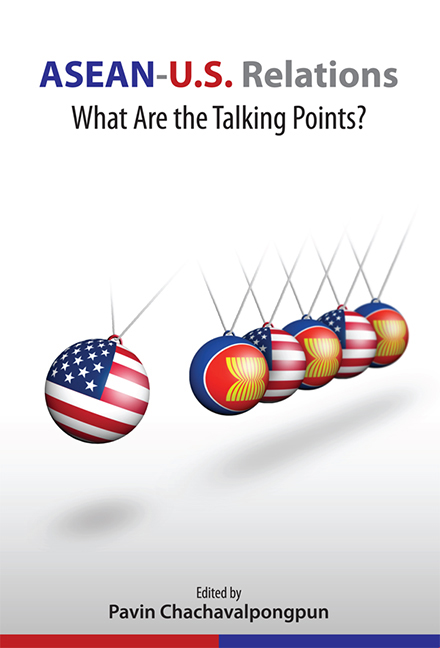Book contents
- Frontmatter
- Contents
- List of Tables and Figures
- Preface
- Contributors
- List of Abbreviations
- OVERVIEW
- QUINTESSENTIAL ISSUES
- 6 A New Era in the Long-Standing U.S.-ASEAN Relationship
- 7 Maritime Security in Southeast Asia and the United States
- 8 ASEAN's View on the U.S. Military Role in the Region
- 9 United States–China Relations
- 10 Shift in U.S. Policy towards Myanmar
- 11 United States Assistance to ASEAN through the ADVANCE Programme
- 12 Conclusion
- Index
12 - Conclusion
from QUINTESSENTIAL ISSUES
Published online by Cambridge University Press: 21 October 2015
- Frontmatter
- Contents
- List of Tables and Figures
- Preface
- Contributors
- List of Abbreviations
- OVERVIEW
- QUINTESSENTIAL ISSUES
- 6 A New Era in the Long-Standing U.S.-ASEAN Relationship
- 7 Maritime Security in Southeast Asia and the United States
- 8 ASEAN's View on the U.S. Military Role in the Region
- 9 United States–China Relations
- 10 Shift in U.S. Policy towards Myanmar
- 11 United States Assistance to ASEAN through the ADVANCE Programme
- 12 Conclusion
- Index
Summary
In July 2010, the ASEAN Studies Centre of the Institute of Southeast Asian Studies organized a workshop on ASEAN-United States relations. The workshop entertained lively discussions on topics related to the overall theme — what are the talking points?
In the first session, on political cooperation, the issue of the South China Sea dominated the discussion. Here are some of the comments and questions:
• The United States has a major stake in the region's peace and stability. But it has no clear policy on the South China Sea. So far, Washington has seemed to adopt a non-interference policy with regard to the territorial dispute in the South China Sea. Can the United States really stay out of the current conflict when, in fact, the conflict may pose a threat to its interest in the region? The United States has over the years forged a close military alliance with certain members of ASEAN through a series of military exercises. Will such exercises permit the United States to play a role in the South China Sea? U.S. Defence Minister Robert Gates once said that the United States was willing to help countries in the region to step up their naval capacity and to support them in preventing the tension in the South China Sea from developing into a real threat.
• China has never had a well-defined policy with regard to the South China Sea. But this ambiguity is beneficial for China as it negotiates with other claimants.
• The strength of the U.S. Navy peaked during the Cold War, but has gradually declined since. This coincided with the modernization of the People's Liberation Army (PLA) of China. In the meantime, Southeast Asia has increasingly become a “vulnerable flashpoint” as maritime terrorism continues to challenge regional peace and security. How will the United States and rising China use their available resources to cope with that threat?
• Has the U.S. presence in Southeast Asia been used to counter China's military modernization? A Chinese scholar raised this question: What would be the United States’ option in view of China's increasingly modernized army/navy? He also commented that China's military rise was a natural phenomenon, after long years of economic growth. Moreover, the shift in the balance of power in the region seems to be in China's favour. China has come to fill the leadership vacuum.
- Type
- Chapter
- Information
- ASEAN-U.S. RelationsWhat Are the Talking Points?, pp. 122 - 126Publisher: ISEAS–Yusof Ishak InstitutePrint publication year: 2011



